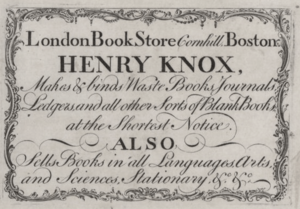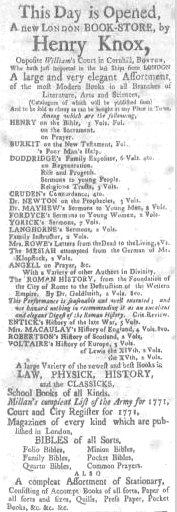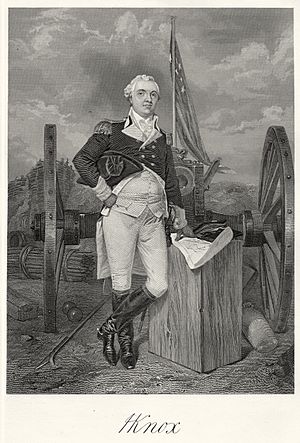Henry Knox facts for kids
{{Infobox officeholder | image = Henry Knox by Gilbert Stuart 1806.jpeg | caption = Portrait by Gilbert Stuart, 1806 (Museum of Fine Arts, Boston) | alt = Portrait of General Knox in military uniform | office = 1st Senior Officer of the U.S. Army | term_start = December 23, 1783 | term_end = June 20, 1784 | appointer = Confederation Congress | predecessor = George Washington (Commander-in-Chief) | successor = John Doughty | office1 = 2nd United States Secretary at War | term_start1 = March 8, 1785 | term_end1 = September 12, 1789 | appointer1 = Confederation Congress | predecessor1 = Benjamin Lincoln | successor1 = Office abolished | office2 = 1st United States Secretary of War | president2 = George Washington | term_start2 = September 12, 1789 | term_end2 = December 31, 1794 | predecessor2 = Office established | successor2 = Timothy Pickering | birth_date = July 25, 1750 | birth_place = Boston, Massachusetts Bay, British America | death_date = October 25, 1806 (aged 56) | death_place = Thomaston, District of Maine, Massachusetts, U.S. | party = Federalist | spouse =
| children = 3 | relatives = Henry Thatcher (grandson) | signature = Henry Knox Signature2.svg | allegiance = ![]() United States | branch = Continental Army
United States | branch = Continental Army
United States Army | serviceyears = 1772–1785 | rank = ![]() Major General | commands = Chief of Artillery
Major General | commands = Chief of Artillery
| battles =
Henry Knox (July 25, 1750 – October 25, 1806) was an important leader during the American Revolutionary War. He was a senior general in the Continental Army, serving as the main artillery officer in most of George Washington's battles. After the war, he led the War Department from 1785 to 1789.
When Washington became the first President, he chose Knox to be the nation's first Secretary of War. Knox held this job from 1789 to 1794. Today, he is perhaps best known because Fort Knox in Kentucky is named after him. This fort holds a large part of the nation's gold reserves.
Born and raised in Boston, Knox owned a bookstore. He loved reading about military history and joined a local artillery group. In 1775, when the American Revolutionary War began, Knox was only 25. He planned and carried out the amazing task of moving captured cannons from Fort Ticonderoga in New York. These cannons helped force the British out of Boston in early 1776.
Knox quickly became the chief artillery officer for the Continental Army. He fought alongside Washington in many major battles. He also set up training centers for artillery soldiers and factories to make weapons. These efforts were very important in helping America win its independence.
In 1785, the Congress made Knox the Secretary of War. He mostly handled issues with Native American tribes. After the U.S. Constitution was adopted in 1789, he became President Washington's Secretary of War. In this role, he helped build forts along the coast and improved local militia groups. He also led military actions in the Northwest Indian War. Knox retired in 1795 to Thomaston, Maine, where he managed large business ventures. He died in 1806.
Contents
Early Life and Family
Henry Knox's parents, William and Mary, were immigrants from Ireland. They moved to Boston in 1729. His father was a shipbuilder who faced money problems and left the family. He died in 1762.
Henry went to the Boston Latin School, where he learned Greek, Latin, math, and history. When his father died, Henry was only 9. He had to leave school to work in a bookstore to help his mother. The store owner, Nicholas Bowes, became like a father to him. He let Henry read any book he wanted. Henry taught himself French, learned about philosophy and advanced math, and read many stories about ancient warriors and famous battles.
Knox was also involved in Boston's street groups. At 18, he joined a local artillery company called The Train.
On March 5, 1770, Knox saw the Boston Massacre. He tried to calm the situation and convince the British soldiers to go back to their barracks. He also spoke at the soldiers' trials. In 1771, he opened his own bookshop in Boston. It was a popular place for British officers and wealthy Bostonians. Knox sold many English books and became friends with his customers. He also studied military science and asked soldiers about their experiences. His business did well at first, but profits dropped after the British closed Boston's port.
In 1772, he helped start the Boston Grenadier Corps. Before his 23rd birthday, Knox accidentally shot two fingers off his left hand. He managed to get to a doctor, who sewed the wound.
Knox supported the Sons of Liberty, a group that protested British policies. He may have been involved in the 1773 Boston Tea Party. He stood guard to make sure no tea was unloaded from one of the ships.
Henry married Lucy Flucker on June 16, 1774. Lucy's father was a Loyalist and did not approve of the marriage because of their different political views. Despite long times apart during the war, Henry and Lucy were very devoted to each other. They wrote many letters. After they left Boston in 1775, Lucy had no home until the British left the city in March 1776. Even then, she often traveled to visit Knox during the war.
Military Career
Siege of Boston
When the war started on April 19, 1775, Knox and Lucy secretly left Boston. Knox joined the militia army that was surrounding the city. His bookstore was looted. He used his engineering skills to build forts around Boston. He also directed cannon fire at the Battle of Bunker Hill.
When General George Washington arrived in July 1775, he was impressed by Knox's work. They quickly became friends. Knox did not have an official army rank yet. However, John Adams helped him get a commission as a colonel in the army's artillery regiment.

As the siege continued, someone suggested that cannons captured from Fort Ticonderoga and Fort Crown Point in New York could help win the fight. Knox is usually given credit for this idea. Washington put him in charge of getting the cannons.
Knox began what became known as the "noble train of artillery". He used ox-drawn sleds to move 60 tons of cannons and other weapons. They traveled about 300 miles (480 km) across frozen rivers and snowy mountains to Boston. The journey was very difficult. Cannons sometimes fell through the ice, but the men always recovered them. What Knox thought would take two weeks actually took more than six. He finally reported the weapons' arrival to Washington on January 27, 1776. This effort is remembered as one of the most amazing feats of planning in the war.
When the cannons arrived, they were used to fortify Dorchester Heights. This new position overlooked Boston harbor so well that the British left the city. After the siege ended, Knox worked to improve defenses in Connecticut, Rhode Island, and New York City. He became friends with Alexander Hamilton in New York.
New York and New Jersey Battles
Knox was with Washington's army during the New York and New Jersey campaign. He was in most of the big battles where New York City was lost. He barely escaped capture when the British invaded Manhattan.
He was in charge of getting the army across the Delaware River before the Battle of Trenton on December 26, 1776. Despite ice and cold, he got the soldiers, horses, and cannons across the river safely. After the battle, he brought everyone back across the river, including hundreds of prisoners and captured supplies. Knox was promoted to brigadier general for this success. He was given command of a larger artillery force. The army crossed the river again a few days later. Knox was with the army at the Battle of the Assunpink Creek and the Battle of Princeton in January 1777.
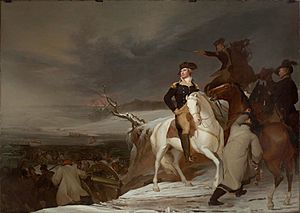
In 1777, while the army was in winter camp, Knox went back to Massachusetts. He worked to improve the army's ability to make artillery. He recruited more artillery soldiers and set up an armory at Springfield, Massachusetts. This armory and another one in Pennsylvania became important sources of war supplies.
Philadelphia Campaign
Knox returned to the main army for the 1777 campaign. He was at the Battle of Brandywine and the Battle of Germantown. At Germantown, he suggested capturing the Chew House, a strong stone building held by the British. This decision delayed the army's advance and gave the British time to regroup. Knox later wrote that the fog and the British holding the stone buildings caused them to lose the victory.
Knox was also at the Battle of Monmouth in July 1778. Washington praised his artillery's performance there.
Artillery Training and Yorktown
Knox and the artillery set up a winter camp at Pluckemin, New Jersey. There, Knox started the Continental Army's first school for artillery and officer training. This school was an early version of the United States Military Academy at West Point, New York. General Knox spent most of 1779 training over 1,000 soldiers. Conditions were very tough, with low morale and few supplies.
In 1781, Knox went with Washington's army south. He took part in the important siege of Yorktown. He was active on the battlefield, directing where the artillery should be placed and aimed. The Marquis de Chastellux, a French general, praised Knox's intelligence and speed in gathering and moving cannons. Washington also specifically mentioned Knox's role in the siege.
Ending the War
Knox was promoted to major general on March 22, 1782. He was the army's youngest major general. He helped negotiate prisoner exchanges with the British, but these talks failed. He then became commander of West Point in August 1782.
Knox became involved in talks with the Congress about pensions and overdue pay for soldiers. He wrote a document, signed by many officers, asking Congress to pay all back pay and offer a one-time pension. When rumors of a mutiny spread in March 1783, Washington spoke to the officers. Knox helped calm the situation by proposing motions that showed the officers' loyalty to Washington and Congress. Because of these money issues, Knox and others strongly supported creating a stronger national government.
When news of peace arrived in April 1783, Congress began to reduce the size of the Continental Army. Washington gave Knox daily command of the remaining army. During this time, Knox helped create The Society of the Cincinnati. This was a group for Revolutionary War officers and their descendants. He wrote the group's founding document and was its first Secretary General.
When the British left New York on November 21, 1783, Knox led the American forces that took over. He stood next to Washington during Washington's farewell speech. After Washington resigned his command on December 23, Knox became the senior officer of the army.
Knox resigned from the army in early 1784. He returned to Massachusetts and worked to get back land in Maine that had been taken from his Loyalist in-laws. He built a huge land empire in Maine. He also helped negotiate treaties with the Penobscot Indians.
Secretary of War
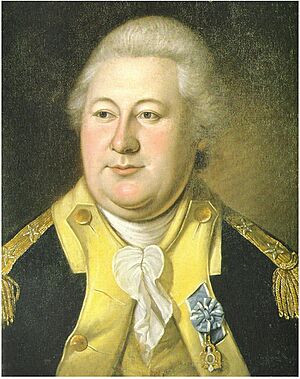
Congress officially made Knox the nation's second Secretary at War on March 8, 1785. Knox was a very large man, about 6 feet 3 inches (1.91 m) tall, and weighed nearly 300 pounds (136 kg) by the 1780s. The army was much smaller then, and conflicts with Native American tribes were increasing as the nation expanded west. The War Department Knox took over had only two civilian employees and one small regiment of soldiers.
Some members of Congress did not want a peacetime army or a military academy. They worried it would create a powerful military class. Knox suggested an army mostly made of state militia. He wanted to change how Congress viewed a military controlled by the people. Many of his ideas were later used to form the United States Army.
The need for a stronger military became clear in 1786 when Shays' Rebellion broke out in Massachusetts. This rebellion threatened the Springfield Armory. Knox went to Springfield to help defend it. This event showed how weak the military was and how the Articles of Confederation limited Congress's power. After the rebellion, Congress called the Constitutional Convention. Knox sent Washington a plan for a government that was very similar to what was later adopted. He also encouraged Washington to attend the convention. Knox actively supported the new Constitution.
With the new Constitution, Knox's title changed to Secretary of War. He was responsible for carrying out the Militia Act of 1792. He found that only 20% of the militia members could arm themselves. To fix this, Knox suggested that the government buy more imported weapons, stop exporting American-made weapons, and build more weapon factories. These included the existing Springfield Armory and another at Harpers Ferry, Virginia. In 1792, Knox helped create the Legion of the United States.
When the French Revolutionary Wars started in 1793, American ships were affected. Both France and Britain seized American ships trading with their enemies. The U.S. Navy had few ships after the Revolutionary War. Knox pushed for and oversaw the creation of a regular United States Navy and a system of coastal forts.
Native American Relations
Knox was in charge of managing the nation's relationships with Native American tribes. He wrote that Indian nations were sovereign and owned the land they lived on. He believed the federal government, not the states, should deal with them. These policies were partly put into action by the Indian Trade and Intercourse Act of 1790. This act made it illegal to sell Native American lands unless it was through a treaty with the federal government. Knox wrote that taking land from them without their consent would be a "great violation of the fundamental laws of nature."
Wars with Native Americans, including the Northwest Indian War, took up much of his time as Secretary. The British supported the northwestern tribes from their forts, which they still occupied after the Revolutionary War. The Cherokee and Creek tribes continued to fight against settlers moving onto their lands.
In October 1790, Knox organized a military campaign led by General Josiah Harmar into the Northwest Territory. This was in response to Native American raids. That campaign failed. A second campaign, led by Governor Arthur St. Clair, also failed badly. These campaigns did not bring peace, and Knox was blamed for not protecting the frontier.
Before leaving office, Knox organized another expedition led by Anthony Wayne. This led to the 1794 Battle of Fallen Timbers, which largely ended the conflict. The result was the Treaty of Greenville, which forced the defeated Native Americans to give up lands in the Ohio area.
Knox tried to make deals with the southern tribes. He promised the U.S. Army would protect them from settlers who wanted their land. Knox believed that using force would be too costly and against American ideals. He suggested giving Native Americans livestock, farming tools, and missionaries to help them become peaceful farmers. Knox signed the Treaty of New York (1790), ending conflict with some Cherokee groups.
Knox noted how the American government and settlers were treating Native American tribes so badly that it was "more destructive to the Indian natives than the conduct of the conquerors of Mexico and Peru." He said that where white settlers lived, Native Americans were almost completely wiped out. Many Native Americans refused to accept treaties, saying they had not approved them. They believed the treaties were only meant to remove them from their lands.
On January 2, 1795, Knox left the government and returned to his home in Thomaston, Maine. He wanted to focus on his family. Timothy Pickering took over as Secretary of War.
Later Life and Legacy
Knox settled in Thomaston and built a beautiful three-story mansion called Montpelier. He spent the rest of his life farming, building ships, making bricks, and dealing in real estate. He had invested widely in land, especially in Maine. Although he claimed to treat settlers fairly, he used others to remove those who did not pay rent or lived on the land without permission. These actions made settlers angry.
Knox was elected a Fellow of the American Academy of Arts and Sciences in 1805.
Knox tried to make more money through businesses, but they often failed. He built up large debts. He was forced to sell large parts of his land in Maine to pay his creditors.
Death
Knox died at his home on October 25, 1806, at age 56. He died three days after swallowing a chicken bone, which caused a fatal infection. He was buried on his estate in Thomaston with full military honors.
Lucy Flucker died in 1824. She sold more of the family's properties to pay off Knox's debts. The couple had three children who lived to adulthood. Their daughter, Lucy Flucker Knox Thatcher, had a son, Henry Thatcher, who became an admiral in the Civil War.
Montpelier, Knox's mansion, was torn down in 1871 to make way for a railroad. The current Montpelier Museum is a reconstruction built in the 20th century.
Honors
Many towns and cities are named after Henry Knox, including places in Maine, Indiana, Iowa, Illinois, Maryland, and Tennessee. Several counties are also named for him, such as in Illinois, Indiana, and Kentucky.
His headquarters in New Windsor, New York, during the Revolution is now the Knox's Headquarters State Historic Site. It is a recognized historic landmark.
The U.S. Postal Service honored Knox with an 8¢ Great Americans series postage stamp on July 25, 1985.
Knox was elected a member of the American Philosophical Society in 1791.
Two forts, Fort Knox in Kentucky and Fort Knox (Maine), are named after him. Knox Hall at Fort Sill, Oklahoma, which is home to the U.S. Army Field Artillery School, is also named in his honor. An annual award for U.S. artillery batteries is also named after him. The large coastal tug USAV Major General Henry Knox (LT-802) is named after him. His papers are kept at the Massachusetts Historical Society.
Images for kids
-
Portrait by Charles Willson Peale, c. 1784 (Philadelphia Museum of Art)
See also
 In Spanish: Henry Knox para niños
In Spanish: Henry Knox para niños


